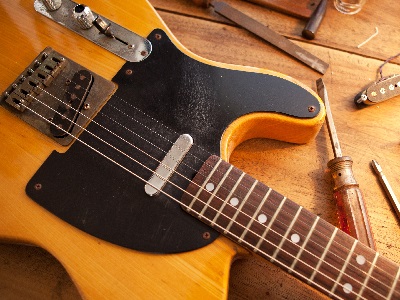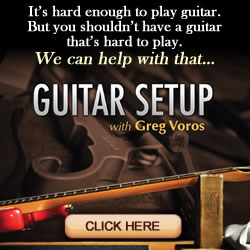Guitar Repair
Who needs to learn guitar repair when you can just pay a luthier to work on your instrument?
Think again.
With some basic skillsets, you would be able to turn a lifeless instrument into a guitar that’s smooth to play on and fix some of the most common problems that other guitar players face.
On top of that, you would no longer have the inconvenience of sourcing from a reliable shop in your area or having to pay expensive fees for simple repair work.
Of course, the million dollar question is, how do you even get started on something that might be totally “alien” to you? While it is possible to get tips on repairing a guitar from your local music store, most people probably don’t have access to a professional guitar repair school or course that they could attend.
That’s where we come in. Here at GuitarPlayerWorld.com, we’ve created a new category of content focusing on repair tips and advice based on the amount of feedback from readers. Honestly, we believe that no guitar learning resources would be complete without discussing some tips on how to take care of your axe.
You Don’t Have to be a Genius to Fix Things
Now, I don’t want to pretend I attended a professional guitar repair school. However, what I do have is a degree in engineering from a leading university and my hands-on experience in a workshop.
Having studied several modules in electronics, chemistry, and wood finishing, I do have a sound knowledge of a guitar’s inner workings. On top of that, I also picked up technical know-hows from a friend who runs his own guitar shop and services.
In this series of lessons, I intend to talk mostly about electric guitars because that is where much of my proficiency lies and also where things go can go wrong most of the time. Hopefully, you will at least get some useful advice to begin with or have basic knowledge in trouble-shooting problems with your instrument.
Diagnosing Trouble Correctly And Applying Correct Remediation
 To begin with, the most common issue that an electric guitar is prone to encountering is crackling, cackling, and popping as soon as you connect the cable to your amp. After you switch the amplifier on, this is usually accompanied by buzzing and then the entire setup might simply go dead.
To begin with, the most common issue that an electric guitar is prone to encountering is crackling, cackling, and popping as soon as you connect the cable to your amp. After you switch the amplifier on, this is usually accompanied by buzzing and then the entire setup might simply go dead.
Plenty of guys will probably say this, “You require a brand-new cable, pal” but actually, what is usually happening is that the surfaces of the cable, guitar amplifier as well as guitar inputs had been oxidized. In layman’s terms, this layer of oxidation prevents an ideal electrical contact.
When this happens, there is a simple solution. Instead of shelling out $15 for a new guitar cable, drop by Home Depot and check out their electrical department. Grab a tin of electrical contact cleanser for $2.00 and keep the $13 you have just saved for something else.
Before You Take Drastic Measures, Try the Simple Solutions First
Next, squirt your cable and rub it using a clean cloth. To cleanse the amplifier and guitar inputs, compress an area of the clean magazine around a Q-tip. Next, apply a bit of contact cleaner to the cloth, and push it in and out of the inputs to all your guitar gear such as effects pedals, amps, and guitar. A point to take note of here is that you should use a fresh new section of the cloth for each jack input.
In the event it does not work out, the next measure is to utilize automotive fine-grade sand paper to decontaminate contact points. Once more, cover this around a Q-tip for jack inputs and replicate the contact cleaner procedure. By now, you should have confirmed any likelihood that the problem is caused by a cleanliness issue. All your equipment should be fresh and clean for your upcoming performance.
While there are several other common guitar repair problems, the truth is that most of these issues do not warrant an entry into the “hospital” requiring a luthier for fixing it up. Sometimes the problems could be due to guitar setup or even simple maintenance routines.
Moving on, we have covered and documented some of the other frequent issues in the articles below. You might want to refer to the corresponding articles to find a solution based on the symptoms your instrument is showing.
Common Problems With Guitars And How to Fix Them:
#1 – How to Fix Guitar Neck Bowing Problems And Prolong Your Instrument’s Life
The fretboard is akin to being the backbone of the guitar. Once it starts bending, you are going to suffer huge problems in playability which result in damage that can be permanent.
#2 – Guide to Help You Fix a Twisted Guitar Neck
A guitar’s neck can get twisted for many reasons and this usually happens due to poor storage conditions. If this occurs to you, you need to check out this guide to help you rectify problems.
#3 – Things You Can Perform For DIY Guitar Fretboard Repair
Overtime, your instrument will undergo wear and tear and suffer from problems with playability. Here’s a quick step by step instructional lesson to help you perform DIY fretboard repairs.
#4 – Tips And Tutorials to Get Started With Your Own Acoustic Guitar Repair
For acoustic guitar owners, it can be quite a hassle and costly to send your instrument for regular repairs. In this tutorial, we teach you tips to get started with basic repairs you can perform at home by yourself.
#5 – Resolving Problems With Electric Guitar Bindings
Learn how to correct issues with damaged electric guitar bindings and avoid doing things that can lead to problems with loose or cracked bindings.
Learn to Fix Your Own Instrument Without Having to go to a Guitar Repair School
The Best Tool For Learning to Play the Guitar
For the ultimate step-by-step guitar system, we highly recommend Gibon’s Learn & Master Guitar course. This award winning DVD course is currently on a 3-day sale and you get to save $100 off the regular price today!
Click here to learn more details and get the course before this promotion ends…
Related Articles
Leave A Comment








3 Comments
Hi There,
I have an acoustic 6 string Ibanez. With the extreme weather we have experienced lately, the bridge was basically ripped off the guitar body. Nothing was broken fortunately. Can you please advise me how to re affix the bridge to the guitar body.
Many Thanks
Ray Hurley
The white plastic strip (nut) on my electric Marigold guitar has cracked and a piece has broken off. I need to replace it. I have found nuts for electric guitars online, but does one fit all electric guitars, or is a certain size required on mine? Would ordering a bone one be more sturdy and less liable to crack?
how do you remove the press on knobs on electric guitar pots with out screwing things up?